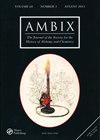面团的酵母,黄金的发酵:中世纪金属嬗变中的面包制作类比。
IF 0.6
3区 哲学
Q3 HISTORY & PHILOSOPHY OF SCIENCE
引用次数: 0
摘要
本文追溯了用发酵剂(酵母或酵母)制作面包与整个中世纪的金属嬗变理论之间的类比关系。为此,本文研究了多部中世纪炼金术著作,其中包括霍图兰斯(Hortulanus)颇具影响力的《翡翠石碑注释》(Commentary on the Emerald Tablet)。在这本著作中,作为哲学家之石重要成分的发酵剂被描绘成一种被动的、有营养的大地(terra nutrix),它与灵魂(anima)相结合,从而产生了石头(青金石)。我认为,这些理论的背景既有实践层面,也有医学理论层面。实践层面源于历史上用酸面团制作面包的日常做法,以及使用旧酵母 "起始物 "作为一种接种物来加速新一批新鲜面团的发酵。理解发酵作用的医学理论框架很可能是由盖伦在药理学中提出的具有广泛影响力的全物质作用(Gr. καθὅλην τὴν οὐσίαν,Lat. tota substantia)思想提供的。这些方面汇聚成一个成功的 "接种-萌发 "模型,它是许多中世纪和现代早期发酵理论的基础,包括医学和炼金术。本文章由计算机程序翻译,如有差异,请以英文原文为准。
Leaven of Dough, Ferment of Gold: The Breadmaking Analogy in Medieval Metallic Transmutation.
This paper traces the analogy between the making of bread with ferment (leaven or yeast) and theories of metallic transmutation throughout the Middle Ages. For this purpose it surveys several medieval alchemical writings, including Hortulanus's influential Commentary on the Emerald Tablet. In this work, the ferment, an essential ingredient of the philosophers' stone, is portrayed less as an active agent and more as the passive, nutritive earth (terra nutrix) which combines with the soul (anima) in order to yield the stone (lapis). I argue that the background of these theories has both a practical and a medical-theoretical dimension. The practical aspect derives from historical everyday practices of making bread from sourdough, and using old yeast "starter" as a kind of inoculum to speed up the fermentation of a new batch of fresh dough. The medical-theoretical framework for the understanding of ferment action was likely provided by the widely influential Galenic idea of whole substance action (Gr. καθ᾽ὅλην τὴν οὐσίαν, Lat. tota substantia), initially developed by Galen in pharmacology and later imported into alchemy via Arabic medicine. Together, these aspects converge into a successful model of "inoculation-emergence," which underlies many medieval and early modern theories of fermentation, both medical and alchemical.
求助全文
通过发布文献求助,成功后即可免费获取论文全文。
去求助
来源期刊

Ambix
HISTORY & PHILOSOPHY OF SCIENCE-
CiteScore
0.80
自引率
60.00%
发文量
42
审稿时长
3 months
期刊介绍:
Ambix is an internationally recognised, peer-reviewed quarterly journal devoted to publishing high-quality, original research and book reviews in the intellectual, social and cultural history of alchemy and chemistry. It publishes studies, discussions, and primary sources relevant to the historical experience of all areas related to alchemy and chemistry covering all periods (ancient to modern) and geographical regions. Ambix publishes individual papers, focused thematic sections and larger special issues (either single or double and usually guest-edited). Topics covered by Ambix include, but are not limited to, interactions between alchemy and chemistry and other disciplines; chemical medicine and pharmacy; molecular sciences; practices allied to material, instrumental, institutional and visual cultures; environmental chemistry; the chemical industry; the appearance of alchemy and chemistry within popular culture; biographical and historiographical studies; and the study of issues related to gender, race, and colonial experience within the context of chemistry.
 求助内容:
求助内容: 应助结果提醒方式:
应助结果提醒方式:


